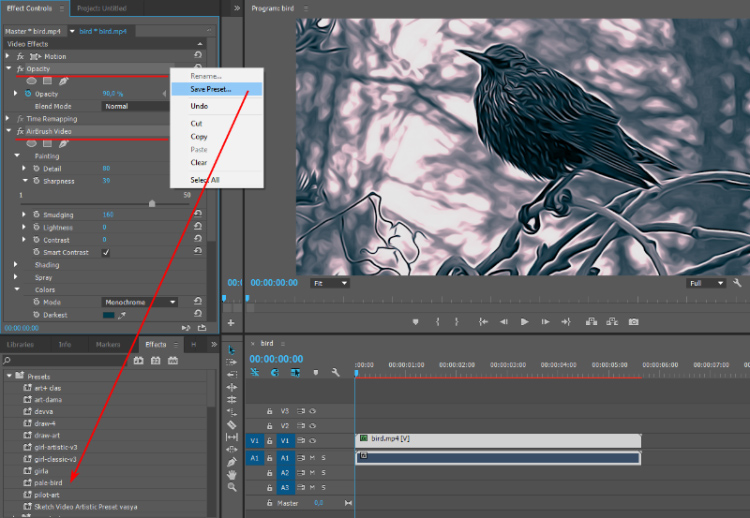
- ADOBE PREMIERE PRO PRESETS NOT SAVING MANUAL
- ADOBE PREMIERE PRO PRESETS NOT SAVING DOWNLOAD
- ADOBE PREMIERE PRO PRESETS NOT SAVING MAC
Right click on one of the highlighted clips and select Proxy/Attach Proxy.Ī new window will open. In your project window, highlight all of your clips. If you are just starting a new project, the first thing you’ll want to do is import all of your ORIGINAL media (not the proxies, yet). This means that you can attach proxies to clips that you’ve already started editing in your sequence, or you can attach proxies before you begin editing. This guide was designed so that it could be implemented at any point in the editing process. Do not close Media Encoder until it finishes the queue. One-by-one, each clip will encode and appear in your target proxy folder. You can monitor your progress in the Encoding panel underneath your Queue. Now press the green play button in the top right corner to begin encoding your proxies! Since you had all of your clips highlighted, this output setting will be applied to every clip in the queue. If your original footage is organized into folders, it is best to copy this organization for your proxies as well. Do not save your proxy media in the same folder as your original media. Navigate to the Proxy folder you created. Click on the blue text under “output file” for one of your clips.
ADOBE PREMIERE PRO PRESETS NOT SAVING MAC
Highlight all the clips in your Queue (Command A on Mac or Control A on PC). Now we need to tell Media Encoder where we want our new proxy media to be saved. This sounds tedious but it is typically much faster than the alternative of dragging and dropping the preset onto each individual clip) (If they did not, remove your clips from the queue and start fresh by applying the preset to one clip then adding the rest again. Highlight the rest of your clips and drag them over into the queue.Ĭheck that these clips actually received the intended preset. Now that you have one clip in your Queue with the intended preset, we can add the rest of your clips and they will automatically receive the same settings. If you see two presets stacked on top of one another, you can highlight the incorrect one and hit backspace/delete to remove it. Your preset should replace the previous text, as seen in the screenshot below. Drop it down on top of the default setting (it should be highlighted blue when you release the mouse button). Click and drag your preset from the Preset Browser to your clip in the Queue. You may notice that it will default to either “Quicktime” or “H.264” but we will change this with our preset. Use the Media Browser panel in the top left to navigate to your video files.ĭrag ONE clip from the Media Browser to the Queue panel on the right. Now that your preset is ready, we can locate your footage. Now you should see your preset in the Preset Browser under “User Presets & Groups” Locate the preset you downloaded from the link above and hit Open. Click the “import presets” button, which looks like a folder with an incoming arrow. On the bottom left of your window, you will see the Preset Browser. This program is automatically installed with Premiere. We have instructions to do so here: Making Custom Presets If your footage was shot at a different resolution, you may need to make your own preset. Smaller resolutions will play with less lag but appear with more pixelation.
ADOBE PREMIERE PRO PRESETS NOT SAVING DOWNLOAD
To make this process more user friendly, the post team has created some presets available here for download: Proxy Presets for Download (NOTE: For security reasons, these presets must be accessed using your account)ĭownload the preset which makes sense based on your footage. We will be making our proxies in Adobe Media Encoder. These files will need to be saved separately.

Make a brand new folder for your proxy media. If you have several day’s worth of footage, make folders to keep each day separate. We suggest keeping all of your original footage in a folder labeled as such. Having control over these settings is important throughout the post production process.īefore we begin making our proxies, make sure that your footage is organized in Finder (Mac) or File Explorer (PC).
ADOBE PREMIERE PRO PRESETS NOT SAVING MANUAL
We are going to take a look at the manual steps because the automatic ‘create proxy’ function in Premiere will limit your settings. There are a few different ways that we can make proxies in Premiere, both manually and automatically. Follow the steps in this guide to create proxies, but don’t forget to relink to your high resolution media before your final export! Making Proxies for Premiere This is particularly helpful if you are working with large 4K+ files or if you are accessing media on Isilon through a VPN.

Although they are lower quality files, they load much faster to allow for smooth playback. Proxies are low resolution copies of your media. Making Proxies for Adobe Premiere Pro What are Proxies?


 0 kommentar(er)
0 kommentar(er)
